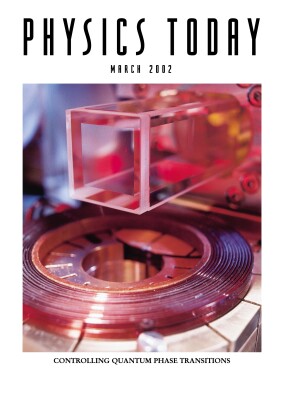In Brief
DOI: 10.1063/1.2408471
The division of atomic, molecular, optical, and plasma physics of the UK’s Institute of Physics awarded the 2001 Sir David Bates Prize last month in the village of Going, Austria, to Raymond Flannery. A Regents’ Professor in the school of physics at the Georgia Institute of Technology, he was acknowledged for his “distinguished contributions to the field of theoretical atomic physics and in particular for his studies of recombination processes with applications to astrophysics and plasma physics.”
John S. Wettlaufer joined Yale University in January as a professor of geophysics and physics. He previously was with the University of Washington, Seattle, where he will remain an affiliate professor of physics.
Last October in Oviedo, Spain, the Prince of Austurias Foundation presented the 2001 Prince of Austurias Award for International Cooperation to the International Space Station. Representatives of the partner space agencies of the ISS who accepted the award were William MacDonald “Mac” Evans, who retired in November 2001 as president of the Canadian Space Agency; Michael Hawes, NASA’s deputy associate administrator for spaceflight (Space Station); Kaname Ikeda, executive director of the National Space Development Agency of Japan; Yuri Koptev, director general of the Russian Aviation and Space Agency; and Antonio Rodotà, director general of the European Space Agency. The foundation recognized the agencies’ efforts “to achieve international cooperation that have been necessary to turn this enormous orbiting laboratory for scientific research for a greater understanding of our planet into a reality.”
In December, NSF announced the recipients of the 2001 Presidential Awards for Excellence in Science, Mathematics and Engineering Mentoring. Included among the winners are two institutions that do physicsrelated work: the National Technical Institute for the Deaf, in the science and engineering department at the Rochester Institute of Technology in New York, and Significant Opportunities in Atmospheric Research and Science at the University Corporation for Atmospheric Research in Boulder, Colorado. The awards, in their sixth year, recognize efforts that enable students from underrepresented groups to pursue careers in science, mathematics, and engineering.
The Science and Technology Foundation of Japan, located in Tokyo, will present Timothy Berners-Lee with the 2002 Japan Prize in the category of computing and computational science and engineering at a ceremony next month. A senior research scientist in the MIT Laboratory for Computer Science, he is being recognized for the “advancement of civilization through [the] invention, implementation, and deployment of the World Wide Web.” Berners-Lee will receive a cash prize of ¥50 million (about $375 000), a medal, and a certificate of merit.
Bruce Berne has won the Joseph O. Hirschfelder Prize in Theoretical Chemistry, awarded last October by the Wisconsin–Madison Theoretical Chemistry Institute and the University of Wisconsin–Madison chemistry department. Berne, Higgins Professor of Chemistry at Columbia University, was recognized for his “theoretical and computer simulation studies of the structural and dynamical properties of molecular liquids.”
This past November, the History of Science Society awarded the 2001 Joseph H. Hazen Education Prize, which recognizes outstanding contributions to the teaching of the history of science, to Stephen G. Brush. According to the society, he “exemplifies how the task of a historian of science does not end with archival work or academic publication, but extends to instantiating historical knowledge in broader communities where the information is relevant.” Brush is a Distinguished University Professor of the History of Science at the University of Maryland, College Park, and holds a joint appointment in the history department and the Institute for Physical Science and Technology.
